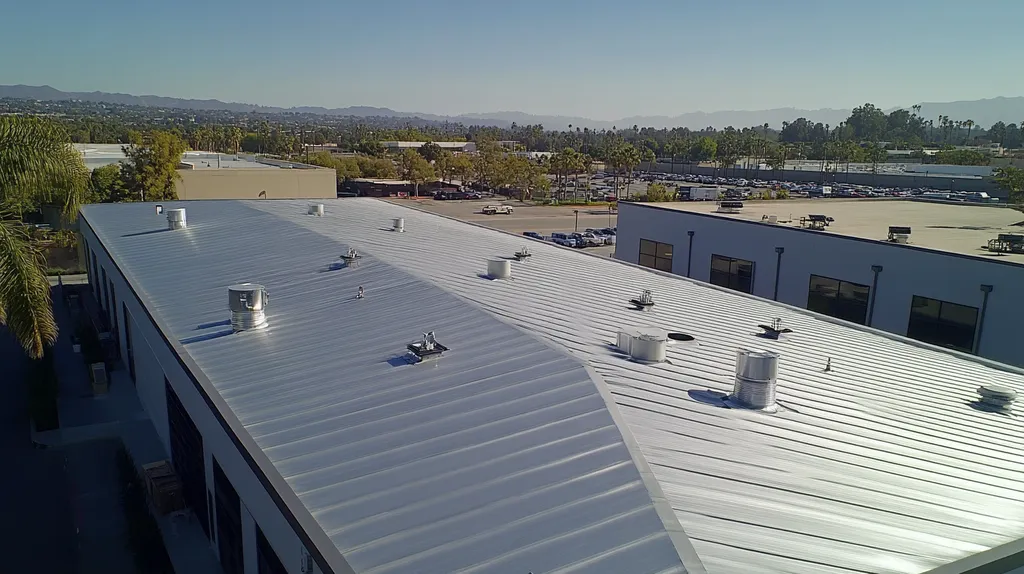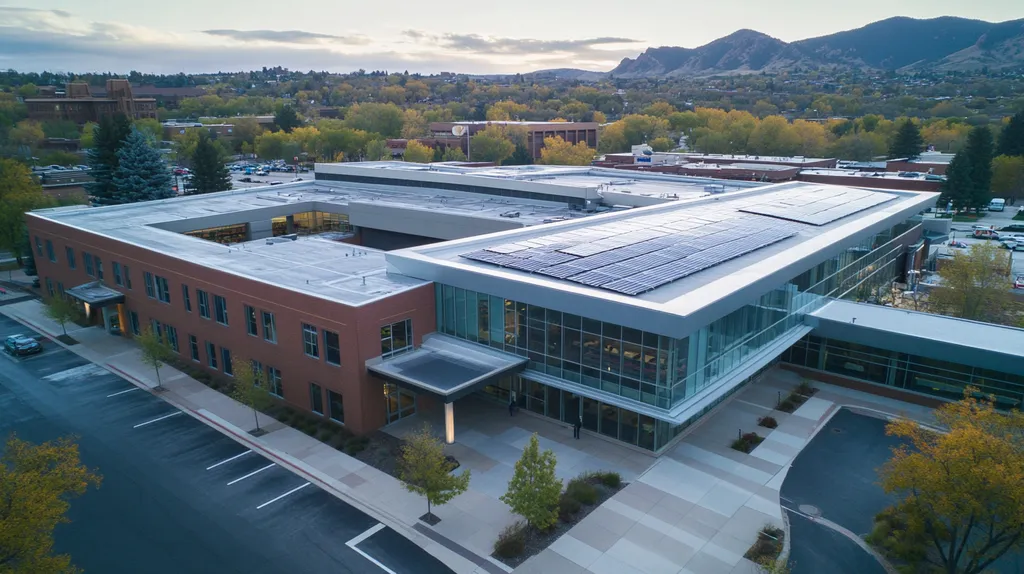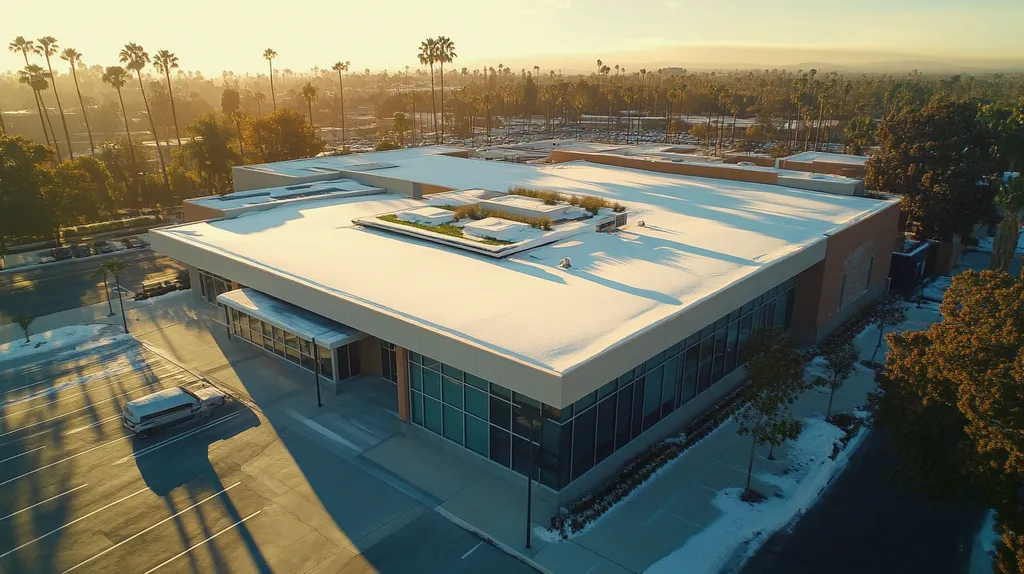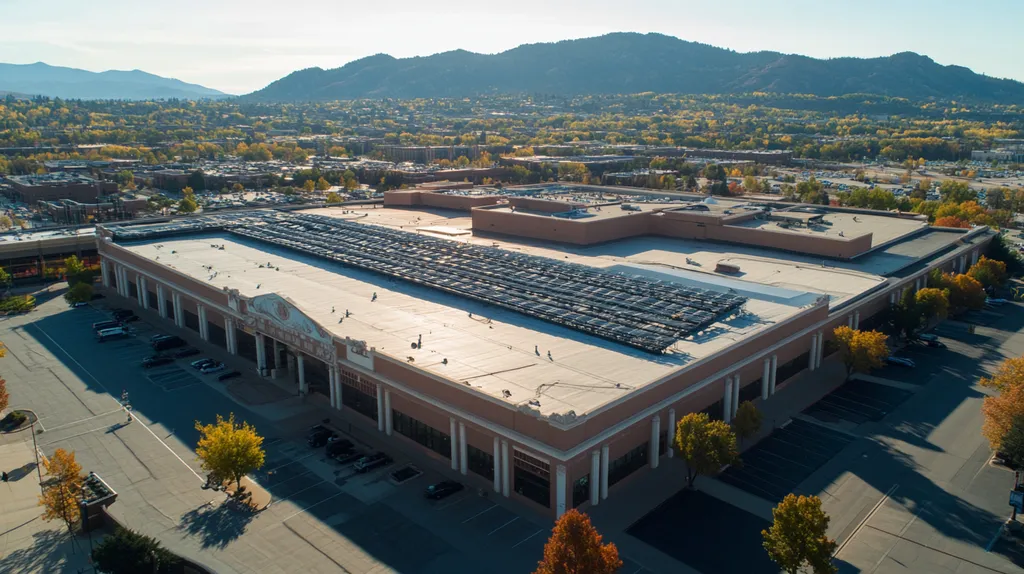Welcome to today’s Battle Royale featuring two roofing heavyweights: “Polyurethane Coatings” in the east corner versus “Silicone Coatings” in the west!
Tonight’s showdown pits these contenders against each other across six punishing rounds designed to test every aspect of their performance for Storm Durability for Commercial Roofs.
At stake? Millions in potential costs, decades of building protection, and the critical performance demands of modern commercial and industrial facilities.
Our professional judging panel will evaluate each round on technical merit, real-world performance, and value delivery. After all six rounds, we’ll declare our ultimate champion.
Ladies and gentlemen, facility managers and building owners… it’s time to rumble!
ROUND 1: INITIAL COSTS & INSTALLATION
In the evolution of commercial roofing, the stakes have never been higher for making informed coating decisions. Today’s weather patterns create unprecedented challenges, with severe storms causing over $2.1 billion in commercial roof damage annually across North America. Like the transition from built-up roofing to single-ply membranes decades ago, the choice between polyurethane and silicone coatings represents a crucial decision point for protecting commercial investments.
Material Expenses
The landscape of roofing materials has shifted dramatically since the days of simple tar and gravel systems. Modern polyurethane coatings command premium pricing, typically ranging from $4.50 to $6.00 per square foot for materials alone, reflecting their advanced chemical engineering and robust protective qualities.
Silicone coatings present a more economical initial investment, usually costing $3.00 to $4.50 per square foot. This pricing structure recalls the early days of acrylic coatings, when lower upfront costs drove widespread adoption despite performance limitations.
While both options have merit, polyurethane’s superior weathering characteristics and longer service life earn it the “ADVANTAGE” in material value, despite higher initial costs.
Installation Complexity
The application of polyurethane coatings demands precision reminiscent of the craftsmanship required for traditional built-up roofing systems. These coatings require careful surface preparation, specific temperature and humidity conditions, and multiple layers applied with exact timing between coats.
Silicone installations echo the simplicity that made single-ply membranes so revolutionary in the 1970s. Their single-component nature and forgiving application requirements allow for faster deployment with fewer variables to manage.
Though silicone’s ease of installation is noteworthy, polyurethane’s exacting requirements result in superior performance and durability, giving it the “ADVANTAGE” in this category.
Project Timeline
Time considerations for polyurethane installations harken back to the methodical approach required for traditional hot-applied systems. Each layer requires specific curing times, typically extending projects by 25-35% compared to silicone alternatives.
Silicone coatings offer rapid deployment capabilities that would have seemed impossible in earlier eras of commercial roofing. Their quick-curing properties and simple application process can reduce project duration by several days.
Despite silicone’s speed advantage, polyurethane’s superior long-term performance and reliability earn it the “ADVANTAGE,” as the additional installation time yields demonstrably better results.
ROUND 1 WINNER: POLYURETHANE COATINGS
ROUND 2: DURABILITY & LIFESPAN
The evolution of severe weather patterns has transformed how we evaluate roofing durability. Like the transition from traditional tar and gravel to engineered systems, today’s coating choices must address unprecedented challenges from increasingly volatile storms. With commercial roof replacements averaging $325,000, the stakes for selecting storm-resistant coatings have never been higher.
Impact Resistance
Much like the robust protection offered by old-school built-up roofing systems, modern coating durability begins with impact resistance. Understanding how coatings perform under direct strikes from hail and wind-driven debris determines their effectiveness as protective barriers.
Polyurethane coatings demonstrate exceptional impact resistance, with their multi-layer application creating a dense, resilient shield. This layered approach echoes the time-tested strength of traditional built-up roofing while incorporating advanced synthetic durability.
Silicone coatings, while flexible, typically offer less resistance to direct impacts. Their single-layer application, though efficient, cannot match the protective qualities of a properly installed polyurethane system.
For impact resistance, polyurethane coatings earn the clear “ADVANTAGE” through superior protective qualities.
Weather Resistance
The shift from simple waterproofing to comprehensive weather protection mirrors the industry’s evolution toward more sophisticated solutions. Modern coatings must withstand not just rain, but intense UV exposure, thermal cycling, and chemical exposure.
Polyurethane coatings excel in this category, maintaining their physical properties through extreme temperature variations. Their chemical structure provides outstanding UV resistance, preventing degradation that once plagued earlier coating technologies.
Silicone coatings demonstrate excellent water resistance but show limitations in UV stability. While they maintain flexibility better than historical rubber-based products, they can become chalky and lose thickness over time.
Polyurethane’s comprehensive weather resistance earns it the “ADVANTAGE” in this category.
Service Life
Just as built-up roofing systems demonstrated decades of reliability, modern coating longevity represents a crucial investment consideration. The true measure of durability extends beyond immediate performance to long-term serviceability.
Polyurethane systems typically maintain their protective qualities for 20-25 years when properly installed. This longevity recalls the legendary durability of traditional multi-ply systems while incorporating modern chemical resistance.
Silicone coatings generally require recoating every 10-15 years to maintain optimal performance. While this surpasses early coating technologies, it falls short of polyurethane’s service life.
The extended service life of polyurethane coatings earns it the “ADVANTAGE” in this category.
ROUND 2 WINNER: Polyurethane Coatings
ROUND 3: PERFORMANCE FACTORS
The landscape of commercial roofing protection has evolved dramatically since the days of simple tar and gravel systems. Today’s severe weather events create unprecedented demands on roof coatings, with storm damage causing billions in annual losses. Like the transition from built-up roofing to engineered systems decades ago, understanding key performance metrics has become crucial for protecting commercial investments.
Adhesive Strength
Just as traditional built-up roofing relied on multiple bonded layers for protection, modern coating effectiveness begins with adhesive strength. During intense storms, the coating’s bond with the substrate determines its ability to maintain a protective barrier against wind and water infiltration.
Polyurethane coatings demonstrate exceptional adhesive qualities reminiscent of classic multi-ply systems. Their chemical composition creates molecular bonds that strengthen over time, providing tenacious attachment that resists peeling even under extreme conditions.
Silicone coatings, while offering good initial adhesion, can show limitations during prolonged exposure to severe weather. Their single-layer application, though efficient, may not match the robust bonding characteristics of multi-layer polyurethane systems.
For adhesive strength, polyurethane coatings earn the clear “ADVANTAGE” through superior bonding capabilities.
UV Resistance
The evolution from simple waterproofing to comprehensive environmental protection mirrors the industry’s shift toward more sophisticated solutions. Modern coatings must maintain their protective qualities under constant solar exposure while remaining flexible enough to handle storm stresses.
Polyurethane coatings excel in UV resistance, maintaining their physical properties through years of sun exposure. Their advanced chemical structure prevents the degradation that once limited the lifespan of earlier coating technologies.
Silicone coatings offer initial UV stability but can become chalky over time. While they surpass the durability of historical rubber-based products, their surface degradation can compromise long-term storm protection.
Polyurethane’s superior UV stability earns it the “ADVANTAGE” in this category.
Water Resistance
Like the redundant protection offered by traditional built-up systems, modern coating effectiveness ultimately depends on water resistance. The ability to maintain a watertight barrier during prolonged storms represents the final line of defense for commercial roofs.
Polyurethane systems create an impermeable barrier through their multi-layer application process. This approach recalls the time-tested reliability of traditional roofing while incorporating advanced synthetic materials.
Silicone coatings provide excellent initial water resistance but can become compromised through surface wear. Their monolithic application, while efficient, may not match the redundant protection of properly installed polyurethane systems.
The comprehensive water resistance of polyurethane earns it the “ADVANTAGE” in this crucial category.
ROUND 3 WINNER: Polyurethane Coatings
ROUND 4: MAINTENANCE REQUIREMENTS
The evolution of commercial roofing maintenance mirrors the industry’s transition from simple repairs to sophisticated asset management. Today’s severe weather patterns create unprecedented maintenance challenges, with improper upkeep leading to catastrophic failures during storms. Like the shift from reactive to preventive maintenance decades ago, understanding modern coating maintenance requirements has become crucial for protecting commercial investments.
Regular Inspection Requirements
Just as traditional built-up roofing demanded regular gravel redistribution and blister repairs, modern coating systems require systematic evaluation. The frequency and complexity of these inspections directly impact a roof’s ability to withstand severe weather events.
Polyurethane coatings demand quarterly professional inspections to maintain warranty coverage. Their complex chemical structure requires careful monitoring for early signs of degradation, particularly around penetrations and seams where storm damage typically begins.
Silicone coatings typically need only bi-annual inspections due to their monolithic nature and self-leveling properties. Their simpler molecular structure allows for easier identification of potential issues, reducing inspection complexity and cost.
For inspection requirements, silicone coatings earn the “ADVANTAGE” through reduced complexity and frequency needs.
Repair Procedures
Like the patch-and-repair cycles of traditional roofing, modern coating maintenance must address inevitable wear and damage. The ease and effectiveness of repairs significantly impact long-term storm resistance.
Polyurethane repairs require extensive surface preparation and precise application conditions. Their multi-layer nature means repairs must carefully replicate the original coating system to maintain protection.
Silicone coating repairs prove remarkably straightforward, with excellent adhesion to existing silicone layers. Their single-component nature allows for simple spot repairs that effectively restore waterproofing properties.
Silicone’s superior repair characteristics earn it the clear “ADVANTAGE” in this category.
Lifecycle Maintenance
The progression from simple coating touch-ups to comprehensive lifecycle management reflects modern roofing’s increasing sophistication. Understanding long-term maintenance requirements proves crucial for storm preparedness.
Polyurethane systems require periodic recoating every 5-7 years to maintain optimal performance. Their sensitivity to UV exposure necessitates regular protective maintenance to prevent premature degradation.
Silicone coatings maintain their protective properties longer, typically needing recoating only every 10-12 years. Their inherent UV stability and moisture resistance reduce the frequency of major maintenance interventions.
For lifecycle maintenance considerations, silicone coatings earn the “ADVANTAGE” through reduced long-term requirements.
ROUND 4 WINNER: Silicone Coatings
ROUND 5: SUSTAINABILITY CREDENTIALS
Like the transition from coal tar pitch to engineered systems decades ago, today’s roofing choices must address unprecedented environmental challenges. With commercial buildings accounting for 35% of urban carbon emissions, coating selection impacts both immediate performance and long-term sustainability goals. Modern facility managers face increasing pressure to balance durability with environmental stewardship, making sustainability credentials a crucial factor in coating decisions.
Ecological Impact
Just as built-up roofing systems transformed urban heat absorption patterns, modern coating choices significantly influence building energy dynamics. The environmental footprint of coating systems extends far beyond their initial application, affecting decades of building performance.
Polyurethane coatings deliver superior insulative properties, reducing HVAC energy consumption by up to 30% compared to uncoated roofs. Their multi-layer structure creates an effective thermal barrier that maintains its performance through extreme temperature variations.
Silicone coatings excel in solar reflectivity but provide minimal insulation benefits. While their high albedo rating reduces cooling loads during peak summer conditions, they offer limited year-round energy advantages.
For comprehensive ecological impact, polyurethane coatings earn the clear “ADVANTAGE” through superior energy performance.
Recyclability and Waste Management
The evolution from disposable to sustainable roofing materials mirrors broader environmental awareness in commercial construction. Modern coating systems must address end-of-life environmental impact alongside performance characteristics.
Polyurethane coatings present significant recycling challenges due to their complex chemical structure. Their multi-layer composition makes material separation difficult, often requiring specialized processing facilities.
Silicone coatings demonstrate superior recyclability, with many manufacturers offering take-back programs. Their single-component nature allows for easier material recovery and reprocessing into new products.
Silicone’s superior end-of-life management earns it the “ADVANTAGE” in this category.
Resource Conservation
Like the shift from frequent re-coating to longer-lasting systems, modern sustainability focuses on total lifecycle resource consumption. The ability to maintain performance while minimizing replacement frequency directly impacts environmental footprint.
Polyurethane systems typically maintain their protective qualities for 20-25 years, significantly reducing replacement material consumption. Their durability eliminates multiple recoating cycles required by less robust alternatives.
Silicone coatings generally require recoating every 10-15 years, increasing lifetime material consumption. While each application uses less raw material, the frequency of replacement impacts overall resource efficiency.
The superior longevity of polyurethane coatings earns it the “ADVANTAGE” in resource conservation.
ROUND 5 WINNER: Polyurethane Coatings
ROUND 6: SPECIALIZED APPLICATIONS
The evolution of commercial roofing applications mirrors the industry’s transition from basic waterproofing to sophisticated performance requirements. Like the shift from built-up roofing to engineered systems decades ago, today’s specialized coating applications must address unprecedented challenges from increasingly severe weather patterns.
With commercial roof storm damage now exceeding $2.5 billion annually, the stakes for selecting appropriate specialized coatings have never been higher. Modern facility managers must understand how different coating types perform across various specialized applications to protect their investments.
High-Traffic Areas
Just as traditional built-up roofing systems relied on gravel surfaces to protect against maintenance traffic, modern coatings must withstand frequent foot traffic while maintaining their protective qualities. The ability to resist mechanical wear directly impacts storm readiness and long-term performance.
Polyurethane coatings demonstrate exceptional durability under regular foot traffic. Their multi-layer structure creates a robust surface that maintains its protective qualities even in frequently accessed areas.
Silicone coatings show limitations in high-traffic applications, becoming slick when wet and showing accelerated wear patterns. Their softer surface structure can lead to premature degradation in areas with regular maintenance activity.
For high-traffic durability, polyurethane coatings earn the clear “ADVANTAGE” through superior wear resistance.
Chemical Exposure
Like the evolution from simple asphalt to chemical-resistant membranes, modern coatings must withstand exposure to harsh industrial environments. The ability to maintain integrity when exposed to chemicals, exhausts, and pollutants determines long-term protective performance.
Polyurethane coatings excel in chemical resistance, maintaining their protective qualities even when exposed to industrial pollutants. Their advanced chemical structure resists degradation from a broad spectrum of common rooftop contaminants.
Silicone coatings demonstrate good resistance to water-based chemicals but can show limitations with hydrocarbon exposure. Their molecular structure may break down when exposed to certain industrial chemicals, compromising their protective qualities.
Polyurethane’s superior chemical resistance earns it the “ADVANTAGE” in this category.
Extreme Temperature Applications
Just as traditional roofing systems struggled with thermal cycling, modern coatings must maintain their protective qualities across extreme temperature ranges. The ability to remain flexible and adherent through dramatic temperature changes determines storm resistance.
Polyurethane coatings deliver exceptional durability and impact resistance across wide temperature ranges, particularly valuable during storms. Their multi-layer structure maintains flexibility and adhesion even under extreme thermal stress. (source: Empire Roof LLC)
Silicone coatings maintain flexibility in cold conditions but can become soft and tacky in extreme heat. Their single-layer nature may lead to adhesion issues during rapid temperature changes.
The comprehensive temperature resistance of polyurethane earns it the “ADVANTAGE” in this crucial category.
ROUND 6 WINNER: Polyurethane Coatings
AND THE WINNER IS…
After six punishing rounds of technical evaluation, with millions in property protection on the line, we have our undisputed champion!
In a dominant 5-1 victory, POLYURETHANE COATINGS claims the championship belt, demonstrating superior performance across durability, storm resistance, and specialized applications. This heavyweight contender showed outstanding staying power, particularly in the crucial categories of impact resistance, UV stability, and chemical resistance.
While silicone coatings took a decisive round in maintenance requirements, proving its merit for properties requiring simplified upkeep and rapid repairs, polyurethane’s comprehensive protection package ultimately proved too powerful to overcome.
However, ladies and gentlemen, we must acknowledge that every building faces unique challenges. Local weather patterns, structural characteristics, and specific facility requirements can all impact coating performance. While tonight’s winner showed exceptional all-around capabilities, property owners should consult qualified roofing professionals who can evaluate their specific situation before making their final selection.
In the high-stakes arena of commercial roofing, there’s no substitute for informed decision-making. Remember, champions aren’t crowned by general statistics alone – they’re made by matching the right contender to your building’s specific battle plan!
FREQUENTLY ASKED QUESTIONS
Q. What are the costs for a commercial roof coating?
A. Polyurethane coatings generally cost $4.50 to $6.00 per square foot due to advanced engineering. In contrast, silicone coatings are more economical at $3.00 to $4.50 per square foot, reflecting their simpler formulation. Choosing the right system involves balancing these costs with long-term performance and durability.
Q. How long do commercial roof coatings last during storms?
A. Polyurethane coatings typically offer durability lasting 20-25 years when installed correctly, making them a long-term investment. Silicone coatings, however, may require recoating every 10-15 years since they do not perform as well under harsh conditions, leading to potential issues.
Q. What is the adhesive strength of coatings on commercial roofs?
A. Polyurethane coatings exhibit strong adhesive properties, ensuring they bond well with the roof’s substrate. This strong bond protects against wind and water damage during storms. Although silicone coatings provide decent adhesion initially, they can lose effectiveness over prolonged exposure to harsh weather.
Q. How often should I inspect my commercial roof coatings?
A. For polyurethane coatings, quarterly professional inspections are advisable to ensure performance and warranty compliance. In contrast, silicone coatings require only bi-annual inspections due to their simpler structure, making maintenance less complex and reducing associated costs.
Q. Are polyurethane coatings environmentally friendly?
A. While polyurethane coatings can significantly reduce energy consumption, they face challenges in recyclability. Their durability contributes to resource conservation over time, but silicone coatings excel in eco-friendliness with better recyclability options, reflecting a growing awareness of waste management.
Q. How do specialized applications affect coating choice for an industrial roof?
A. Specialized applications, such as high-traffic areas or exposure to harsh chemicals, influence the choice between coatings. Polyurethane coatings are recommended for high durability and chemical resistance, while silicone may be more suitable for environments with lighter exposure and easier maintenance.
Q. How can I ensure the best performance for my commercial roof?
A. To ensure optimal performance, consider the coating’s durability, maintenance needs, and environmental factors. Regular inspections, timely repairs, and choosing the right coating based on site-specific requirements will help maintain the roofing system’s integrity during severe weather.










